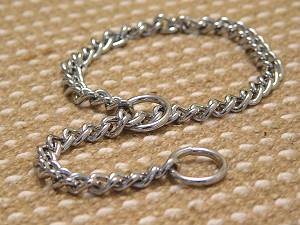Choosing the Correct Collar
I recently went shopping for a new collar. My poor pup really needed one. But I was amazed at the number of collars available and actually was not sure what would be best for my Jack, who is a West Highland White Terrier. What did my dog really need? So I decided to do my homework first and then decide on which is the best collar for keeping control of my dog.
Here are some common types of collars and what you should know about them:
Flat buckle collar
This is your typical collar that most everyone knows and recognizes. It is not used for training, but for some dogs it is all you need. They are simple used to hold identification and tags as well as use for standard leashes.
Martingale collar
If you dog is quite the escape artist when it comes to a regular buckle collar then this is a good choice for everyday training. It adjusts easily and doesn’t choke. You can recognize it from the two loops. The large look goes around your dog’s head and then is adjusted to fit loosely. Your leash is clipped to the “D” ring on the smaller loop. When the dog tries to pull his head out of the collar the leash pulls it taut preventing your precious pup from getting away.
Head collar
The head collar is designed for dogs that are forceful pullers (my husband’s Chesapeake Bay Retriever was one of those). It is also good for use on dogs that have a high prey drive or highly leash reactive. These collars are similar to the halters used on horses, with the idea that were the head goes, the rest of the body will follow. A head collar fastens around the back of the neck and over the top of the muzzle giving you more control, direction and hopefully lessening the level of intensity when your dog pulls. While a very human training tool, some dogs need some time to get used to the feeling of the collar over their muzzle. Also this type of collar should never be used with a retractable leash because it can cause injury to your dog’s neck with a sudden pull or tug of the leash.
Harness
The harness is good for small breeds like toys or dogs that have specific health issues like a sensitive throat or trachea. It is also recommended by trainers to use to teach a dog to say, run on the treadmill, jogging or running next to a bike. But, the least attachment is at the top of the back, so there isn’t as much control if your dog starts pulling.
 Sensation harness
Sensation harness
If your dog is a strong puller or simply needs more control this collar is a good choice. But it is not recommended for those breeds that are adverse to head collars or dogs with pushed in faces.

Slip collars
Sometimes called a “choke chain” a slip collar is a length of chain or nylon rope with rings at each end so the collar can form a loop just around your dog’s neck, just behind the ears. This type of collar tightens when the dog pulls or when the trainer/handler “pops” the least. It is very important that these collars not be left on your dog when not training as numerous dogs are choked to death each year after leaving the “choke” chain on during play time or when the dog was left alone. They are called this name for a reason; they “choke” the dog and in some cases can either make your dog more aggressive or can cause serious tracheal and esophageal damage.
Prong collars
The prong collar is made of interlocking links with two blunt prongs the pinch the dogs’ skin with the collar is tightened. It should fit snugly below your dog’s ears. It trains by putting pressure around the neck by pinching about a half inch wide band of your dog’s skin. Using this type of collar should never be taken lightly, and they should never be used on puppies, aggressive, shy or fearful dogs. Sometimes using the prong collars provides just a temporary stopping of the unwanted behavior and the pain can actually cause aggressive behavior.
Electronic collars
“Shock collars” or “e-collars” these collars use electronic devices to deliver an electronic signal, vibration or tone through the contact points on the collar. These types of collars should not be used until at least two professional trainers or veterinarians have been consulted regarding their safety and effectiveness for your particular breed of dog.
The most important thing when using a collar is to use the one you have chosen correctly. If you are using a training collar it should only be used during – you got it – training sessions. Dogs can be seriously injured if certain types of collars are left on too long or while your pet is playing. If you still can’t decide which is the best collar and training collar for your dog consult a professional dog trainer. There is a list of certified dog training professionals available at the Association of Dog Trainers website (www.apdt.com).
Remember if you are using a training collar they are sort of like the training wheels on your child’s bike. They are meant to come off eventually.
 Hi! My name is Doug Houskins, and YourDogZone.com is my site.
On this site, you can find some of my favorite dog training resources, a directory of
Hi! My name is Doug Houskins, and YourDogZone.com is my site.
On this site, you can find some of my favorite dog training resources, a directory of
[…] (See this article on choosing a collar for more information on the harness) […]